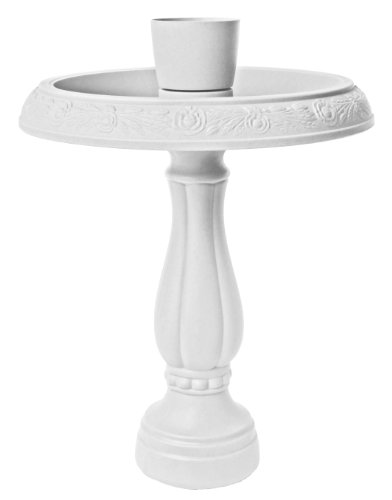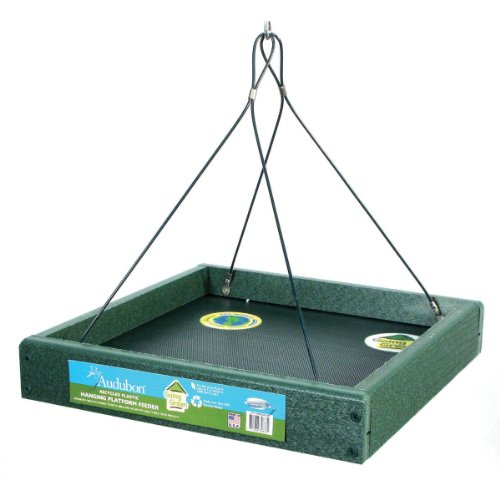
At last you have an aviary in your back yard. Now you have to set it up ready for your beautiful birds. Never put birds into an aviary until you have everything set up to your satisfaction. Finches, in particular, have tiny bodies and very fragile so more susceptible to dying from stress. Therefore, if you put them into the aviary and start going in and out adding things before they have time to settle in, they can become stressed and die.
They will fly around trying to keep out of your way, in a new strange area they could easily fly into the wire mesh trying to avoid you. So please finish setting your aviaries up before adding your birds.

Start with your perches making sure they will not affect the flight area for them. For instance, if you have parrots their wing span is larger than finches so they need more room to open those wings to fly.
Select different size dowelling to suit the varying sizes of the birds feet. Another good idea is to get branches from trees, which vary in size. Cleanliness is the key to having healthy birds. Remove perches from time to time and clean. Scrub in a diluted solution of house bleach.
Never place perches above water or feed, as they will become contaminated with their droppings.
 Bloem 280-10 Flower Pot Bird Bath with Pedestal, White
Bloem 280-10 Flower Pot Bird Bath with Pedestal, WhiteTry to keep all food and water containers off the ground. Prevention of disease is always better than the cure. It is important to prevent contamination from mice urine in the birds food and water.
The depth for water containers for small birds is 13mm (1/2") or up to 50mm (1-2") for the larger birds. Deeper ones could result in baby birds being drowned. If you place a dish off the ground with grease around the stem; this will keep the ants from climbing up into the bird’s food and water.
Beware of using automatic feeders; these can become blocked by husks preventing birds from getting any food. This misleads you into thinking they have enough when in fact they can't get any at all, causing their premature death.
If you decide to create a small pool in your aviary, make sure the sides have a gradual slope, roughen the surface to prevent birds from slipping so they can stand on the edges. You can also place a mesh over the top to prevent birds from drowning.

Place at least two nests for each breed of bird in your aviary before putting birds in. This will stop birds fighting for a nest. I have seen budgerigars killing young babies of other birds in a nest so they can have that particular nest.

Quails do not need nests. They carry small sticks and twigs to build their nest on the floor in a dry place.
Position nests in a dry draft free area where possible, usually higher up in the aviary but not too close to a tin roof as the heat or cold will kill them. Give the birds’ ample material to build their nests. Supply Finches with dry grasses or similar materials. The use of long lengths of wool can cause the birds to become entangled by their legs and die. If you choose this type of material to mix with other straw and twigs cut into very short lengths.
Parrots require wood shavings in the bottom of their nest to help prevent eggs from breaking on the wood surface. When making nests for parrots gouge a bit of wood out to form a hollow for the eggs to rest in among the sawdust.
Most birds like to choose their own nest, therefore, supply more nests than required to avoid arguments in the aviary.
When making wooden nest boxes make sure the timber you use is not chemically treated with any substances. This could be harmful to them, as most curved beaked birds will chew the sides of their nests. This applies to the sawdust used in the nests too.
Use small hinged wooden nests boxes for budgerigars or small parrots. You can make from chipboard as long as it’s kept under cover from weather as it will warp if it becomes wet.
Larger Parrots need a taller, wooden box so their young can’t climb out before they’re old enough to fly. The hinged lid allows easy access for cleaning and disinfecting in the off-season.
For those bird lovers who have often thought of having an aviary then maybe now is the time to either build or buy yourself an aviary and enjoy listening to their beautiful singing.
Birds love to fly into natural plants which can be grown directly in the aviary or in pots. Choose plants carefully as some may be harmful to birds.
 Audubon Going Green Platform Feeder Model NAGGPLAT
Audubon Going Green Platform Feeder Model NAGGPLATIf you buy your birds locally, then quarantine acclimatization isn't necessary.
Quarantine basically means keeping the birds isolated and under close observation for a week, before introducing them into your aviary. Signs of stress and shock from catching and shifting the birds can cause serious illness.
Be very careful when you introduce a new bird to an aviary. Some birds won't accept the mate you have chosen for them. It is a good idea to put them into adjoining cages until they settle down and become accustomed to them.
Just the catching of birds alone can cause them stress, never ever put birds into a strange aviary after midday as they need time to settle and find a roosting site before dark. Flying into the wire of an unfamiliar aviary can result in instant death. Even if the days are longer and it will not get dark for a couple of hours, do not be tempted to put them into a strange aviary late in the day.
Instead give the bird food and water and cover his cage and leave it until the next day. Some birds take longer to acclimatize than others.
Ensure that shelter and cover is adequate; never upset birds during the breeding season unless necessary. Do not go near aviary at night as they may panic and fly into the wire netting.
Always handle a bird with care holding its head between the first two fingers and the body in the palm of your hand. This will help prevent them from biting you, especially when handling parrots or curved beak birds.
Millet sprays are enticing to apprehensive finches. Most Parrots love bananas, apples and oranges. Many finches enjoy live food, like meal worms which you can breed easily and supply your own.

This picture shows an unclean dish which mice can easily access and urinate on the food.
The need to keep a cage or aviary scrupulously clean cannot be over emphasized. Give fresh clean water daily as most birds love to bathe in their water.
A small fine spray gun is ideal to spray the birds if they become too hot. If you have a large aviary you could set up a fine spray from a reticulated hose.
TIP: Try to have equal pairs in your aviary to avoid fights. If you want to breed healthy birds then prevent interbreeding where possible by not allowing father and daughter or mother and son to mate. You can control this by placing different colored rings on legs of babies so you can easily see the babies.
Now it is time to sit back and enjoy watching your beautiful birds entertain you as they bathe, build their nests and rear their little babies.
If you have read this and have any queries or ideas to share, do not hesitate to add or ask in the comments section below.
[1]
Copyright © 2005-2016 Pet Information All Rights Reserved
Contact us: www162date@outlook.com